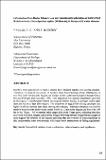| dc.description.abstract | Rainbow trout populations in Kenya streams have declined rapidly over several decades.
Therefore, we studied movements of rainbow trout, Oncorhynchus mykiss (Walbaum), in
two third order streams (the Sagana and Thego) on the southwestern slope of Mount Kenya between February and December 1998. Fish implanted with dummy transmitters and held at the Kiganjo Trout Research Station had surgical wounds healed, on average, within eight days and fed three days after surgery. The proportion of tagged fish moving upstream was higher in all the stations than those moving downstream. Estimated distances traveled by rainbow trout between observations varied from 0 to 1.2 km in the Sagana and from 0 to 1.09 km in the Thego. All recaptured radio-tagged fish in the Thego grew; indicating that they recovered well from surgery, and actively foraged following release. Illegal fishers caught all radio-tagged fish released in the Sagana indicating that the recovery of trout population in this, and probably other trout streams, will require strict enforcement of fishing regulations. | en_US |

